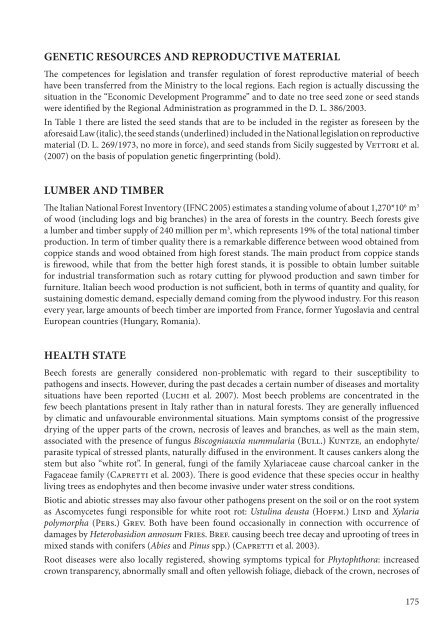Create successful ePaper yourself
Turn your PDF publications into a flip-book with our unique Google optimized e-Paper software.
GeNeTIc resources aNd reProducTIve maTerIaL<br />
The competences for legislation and transfer regulation of forest reproductive material of beech<br />
have been transferred from the Ministry to the local regions. Each region is actually discussing the<br />
situation in the “Economic Development Programme” and to date no tree seed zone or seed stands<br />
were i<strong>de</strong>ntified by the Regional Administration as programmed in the D. L. 386/2003.<br />
In Table 1 there are listed the seed stands that are to be inclu<strong>de</strong>d in the register as foreseen by the<br />
aforesaid Law (italic), the seed stands (un<strong>de</strong>rlined) inclu<strong>de</strong>d in the National legislation on reproductive<br />
material (D. L. 269/19 3, no more in force), and seed stands from Sicily suggested by Vettori et al.<br />
(200 ) on the basis of population genetic fingerprinting (bold).<br />
Lumber aNd TImber<br />
The Italian National Forest Inventory (IFNC 2005) estimates a standing volume of about 1,2 0*10 6 m 3<br />
of wood (including logs and big branches) in the area of forests in the country. Beech forests give<br />
a lumber and timber supply of 240 million per m 3 , which represents 19% of the total national timber<br />
production. In term of timber quality there is a remarkable difference between wood obtained from<br />
coppice stands and wood obtained from high forest stands. The main product from coppice stands<br />
is firewood, while that from the better high forest stands, it is possible to obtain lumber suitable<br />
for industrial transformation such as rotary cutting for plywood production and sawn timber for<br />
furniture. Italian beech wood production is not sufficient, both in terms of quantity and quality, for<br />
sustaining domestic <strong>de</strong>mand, especially <strong>de</strong>mand coming from the plywood industry. For this reason<br />
every year, large amounts of beech timber are imported from France, former Yugoslavia and central<br />
European countries (Hungary, Romania).<br />
heaLTh sTaTe<br />
Beech forests are generally consi<strong>de</strong>red non-problematic with regard to their susceptibility to<br />
pathogens and insects. However, during the past <strong>de</strong>ca<strong>de</strong>s a certain number of diseases and mortality<br />
situations have been reported (Luchi et al. 200 ). Most beech problems are concentrated in the<br />
few beech plantations present in Italy rather than in natural forests. They are generally influenced<br />
by climatic and unfavourable environmental situations. Main symptoms consist of the progressive<br />
drying of the upper parts of the crown, necrosis of leaves and branches, as well as the main stem,<br />
associated with the presence of fungus Biscogniauxia nummularia (Bull.) Kuntze, an endophyte/<br />
parasite typical of stressed plants, naturally diffused in the environment. It causes cankers along the<br />
stem but also “white rot”. In general, fungi of the family Xylariaceae cause charcoal canker in the<br />
Fagaceae family (Capretti et al. 2003). There is good evi<strong>de</strong>nce that these species occur in healthy<br />
living trees as endophytes and then become invasive un<strong>de</strong>r water stress conditions.<br />
Biotic and abiotic stresses may also favour other pathogens present on the soil or on the root system<br />
as Ascomycetes fungi responsible for white root rot: Ustulina <strong>de</strong>usta (Hoffm.) Lind and Xylaria<br />
polymorpha (Pers.) Grev. Both have been found occasionally in connection with occurrence of<br />
damages by Heterobasidion annosum Fries. Bref. causing beech tree <strong>de</strong>cay and uprooting of trees in<br />
mixed stands with conifers (Abies and Pinus spp.) (Capretti et al. 2003).<br />
Root diseases were also locally registered, showing symptoms typical for Phytophthora: increased<br />
crown transparency, abnormally small and often yellowish foliage, dieback of the crown, necroses of<br />
1 5

















